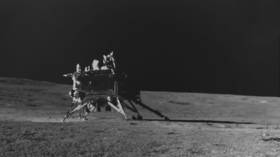India to launch test flight ahead of next big space mission
The ‘Gaganyaan’ project is expected to be launched in 2024 and will carry Indian astronauts to space
India’s space agency will carry out the first of several test flights on October 21 ahead of its planned ‘Gaganyaan’ mission, the country’s science and technology minister announced on Tuesday.
The test vehicle development flight, which will involve the crew module intended to house Indian astronauts during Gaganyaan, will be conducted at the Satish Dhawan Space Center in Sriharikota in the southern state of Andhra Pradesh, according to Union Minister Jeetendra Singh. The Indian Space Research Organization (ISRO) is also ready to test the efficacy of the crew escape system, an integral component of the planned mission.
The test will involve launching the module to outer space, bringing it back to Earth, and recovering it after touchdown in the Bay of Bengal in the northeastern part of the Indian Ocean. The Indian Navy has already started mock drills to prepare for the recovery of the module, Singh said at a program held to congratulate scientists who worked on the historic Chandrayaan-3 mission.
According to an Indian government release, the Gaganyaan project, which is expected to take Indian astronauts to space late next year, “envisages [the] demonstration of human spaceflight capability by launching a human crew to an orbit of 400km and bringing them back safely to Earth, by landing in Indian sea waters.” The spacecraft is designed to carry three people. The first crewed mission was originally planned for December 2021, but was delayed due to the Covid-19 pandemic and safety concerns.
“The tests will set the stage for the first unmanned ‘Gaganyaan’ mission and ultimately manned mission to outer space in low Earth orbit,” Singh said. He added that before the manned mission, there will be a test flight to space next year, which will carry a female-looking humanoid robot called Vyommitra, developed by the ISRO.
According to a government press release, preparations for Gaganyaan have included the development of numerous critical technologies such as the launch vehicle to carry the crew safely to space, life support systems to provide an Earth-like environment for astronauts, emergency escape provisions, and “evolving crew management aspects for training, recovery, and rehabilitation.”
“India’s ambitious space exploration program has left a clear message that we are one of the most scientifically advanced nations in the field of space science and technology,” Singh stated, following the successful launch on Indian missions to the Moon and the Sun in quick succession.
In August, India’s Chandrayaan-3 landed on the South Pole of the Moon in a historic first. Ten days after Chandrayaan-3’s successful voyage to the Moon, India launched the country’s first mission dedicated to observing the Sun, Aditya-L1.
You can share this story on social media:








Comments are closed.